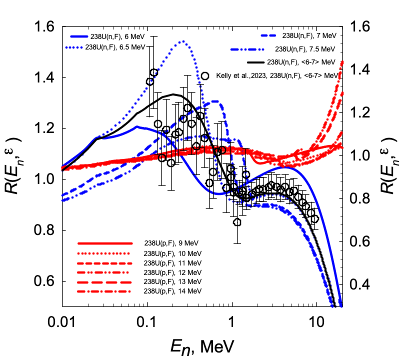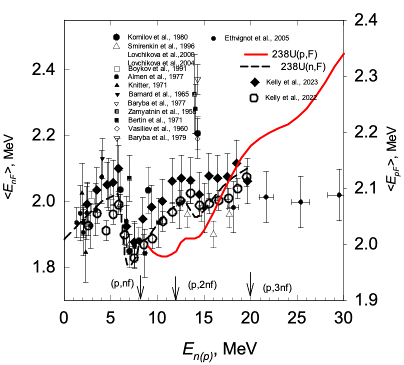Speaker
Description
Pre–fission neutron spectra influence the partitioning of fission energy between excitation energy and total kinetic energy of fission fragments. It might be assumed that the (n,xnf) and (p,xnf) neutron contribution, i.e. PFNS shapes might depend on the entrance channel. For incident neutron energies from fission threshold up to En ~20 MeV prompt fission neutron spectra (PFNS) of 238U(n,F) were predicted in [1] and upgraded as described in [2]. Analysis of detailed data for 238U(n,F) PFNS [3] demonstrates sensitivities of PFNS shape near (n,xnf) reaction thresholds to the exclusive pre–fission neutron spectra. The latter are extremely sensitive to the (n,nγ) and (n,2nγ) competition. Shapes for 238U(n,F) PFNS [1] at excitations around 238U(n,nf) reaction threshold are strongly supported by the measured data of [3]. The average energies [[3] of 238U(n,F) PFNS support the approach pursued in [1, 2], lowering of is consistent with predicted contributions of 238U(n,nf) and 238U(n,2nf) to the observed PFNS and fission cross section. The influence of 238U(n,nf)1 excusive neutron spectra on 238U(n,F) PFNS at En~6–7 MeV is sensitive to the energy En steps of ~0.25 MeV. Integral PFNS is consistent with data [3]. The largest amplitude of excusive neutron spectra at En~6.25 MeV is envisaged. For the reactions 238U(n,F) and 238U (p,F) shape of PFNS and strongly depend on the fissility of composite and residual nuclides, 238+1-xU and 238+1-xNp, respectively (Fig. 1 and 2). The 238U(p,F) PFNS shape is quite different as compared to that of 238U(n,F), since the contributions of pre-fission neutrons are different both in compound and pre-equilibrium domain. Exclusive neutron spectra (p,xnf)1,..x are consistent with fission cross sections of 238U(p,F) and 238U(p,xn) up to En ~30 MeV. We predict 238U(p,xnf)1,..x exclusive pre–fission neutron spectra, exclusive neutron spectra of 238U(p,xn) 1,..x reactions, total kinetic energy TKE of fission fragments and products, partials of average prompt fission neutron number and observed PFNS of 238U(p,F). The dips in PFNS of 238U(p,F) are much shallower than in case of 238U(n,F) reaction. Asymmetry of 238U(p,xnf)1 neutrons with respect to the incident beam momentum is also very small.
Similar analysis/prediction is accomplished for the 232Th(n,F) and 232Th(p,F) PFNS.

Fig. 1 238U(n,F) and 238U(p,F) PFNS, En~6–7 MeV

Fig.2 of 238U(n,F) and 238U(p,F) PFNS
- V.M. Maslov, Yu.V. Porodzinskij,M. Baba et al., Phys. Rev. C, 2004, v. 69, p. 034607(1)—034607(13).
- V.M. Maslov, Physics of Particles and Nuclei, 2025, vol.56, No. 1, p. 64-87.
- K. J. Kelly, M. Devlin, J.M. O’Donnel et al., Phys. Rev. C, 2023, vol. 108, p. 024603.

